
The Morgan Bible, also called the Morgan Picture Bible, Crusader Bible, Shah Abbas Bible or Maciejowski Bible, is a unique medieval illuminated manuscript. It is a picture book Bible consisting of 46 surviving folios. The book consists of miniature paintings of events from the Hebrew Bible, set in the scenery and costumes of thirteenth-century France, and depicted from a Christian perspective. It is not a complete Bible, as it consists largely of illustrations of stories of kings, especially King David. The illustrations are now surrounded by text in three scripts and five languages: Latin, Persian, Arabic, Judeo-Persian, and Hebrew. The level of detail in the images and the remarkable state of preservation of the work make it particularly valuable to scholars.

The Limbourg brothers were Dutch miniature painters from the city of Nijmegen. They were active in the early 15th century in France and Burgundy, working in the International Gothic style.

Books of hours are Christian prayer books, which were used to pray the canonical hours. The use of a book of hours was especially popular in the Middle Ages, and as a result, they are the most common type of surviving medieval illuminated manuscript. Like every manuscript, each manuscript book of hours is unique in one way or another, but most contain a similar collection of texts, prayers and psalms, often with appropriate decorations, for Christian devotion. Illumination or decoration is minimal in many examples, often restricted to decorated capital letters at the start of psalms and other prayers, but books made for wealthy patrons may be extremely lavish, with full-page miniatures. These illustrations would combine picturesque scenes of country life with sacred images.

The Froissart of Louis of Gruuthuse is a heavily illustrated deluxe illuminated manuscript in four volumes, containing a French text of Froissart's Chronicles, written and illuminated in the first half of the 1470s in Bruges, Flanders, in modern Belgium. The text of Froissart's Chronicles is preserved in more than 150 manuscript copies. This is one of the most lavishly illuminated examples, commissioned by Louis of Gruuthuse, a Flemish nobleman and bibliophile. Several leading Flemish illuminators worked on the miniatures.

The Fécamp Bible is an illuminated Latin Bible. It was produced in Paris during the third quarter of the 13th century, and had previously belonged in the collection of Henry Yates Thompson.
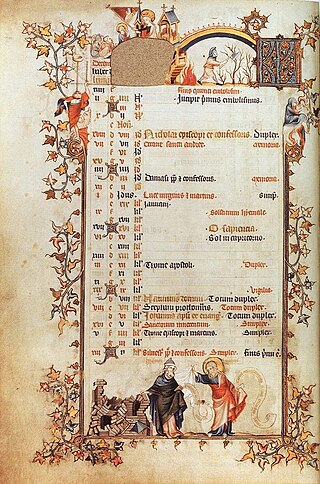
The Belleville Breviary is an illuminated breviary. It was produced in Paris some time between 1323 and 1326 by the artist known as Jean Pucelle, probably for Jeanne de Belleville, the wife of Olivier IV de Clisson. The breviary is divided into two volumes of 446 and 430 folios. Volume 1 contains the prayers used during the summer, while volume 2 contains those used during the winter.

Guillaume de Deguileville was a French Cistercian and writer. His authorship is shown by one acrostic in Le Pèlerinage de la Vie Humaine, two in Le Pèlerinage de l'Âme, and one in Le Pèlerinage de Jhesucrist. These acrostics take the form of a series of stanzas, each beginning with a letter of Deguileville's name. According to indications in the Vie his father was called Thomas, he was named after his godfather, and his patron saint was William of Chaalis. There is no evidence that his name is connected with a village of Guileville.
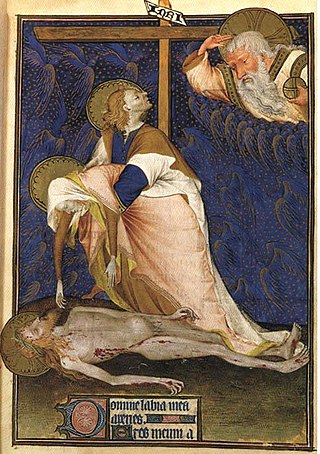
The Grandes Heures de Rohan is an illuminated manuscript book of hours, painted by the anonymous artist known as the Rohan Master, probably between 1418 and 1425, in the Gothic style. It contains the usual offices, prayers and litanies in Latin, along with supplemental texts, decorated with 11 full page, 54 half page, and 227 small miniatures, decorated with tempera paints and gold leaf. The book margins are decorated with Old Testament miniatures with captions in Old French, in the style of a Bible moralisée. The full page illuminations are renowned for the highly emotional and dramatic portrayal of the agonies of Christ and the grief of the Virgin. According to Millard Meiss, "The Rohan Master cared less about what people do than what they feel. Whereas his great predecessors excelled in the description of the novel aspects of the natural world, he explored the realm of human feeling." Meiss concludes that the Rohan Master was the "greatest expressionist in 15th century France." The manuscript is currently housed in the Bibliothèque Nationale, Paris, France.

The Bible Historiale was the predominant medieval translation of the Bible into French. It translates from the Latin Vulgate significant portions from the Bible accompanied by selections from the Historia Scholastica by Peter Comestor, a literal-historical commentary that summarizes and interprets episodes from the historical books of the Bible and situates them chronologically with respect to events from pagan history and mythology.

The Bedford Master was a manuscript illuminator active in Paris during the fifteenth century. He is named for the work he did on two books illustrated for John of Lancaster, 1st Duke of Bedford between 1415 and 1435. One is the Bedford Hours, a book of hours in the British Library ; the other, the Salisbury Breviary, is in the Bibliothèque nationale de France. Another manuscript is in the Royal Collection. The Bedford Master is known to have been the head of a workshop; his chief assistant is known as the Chief Associate of the Bedford Master.
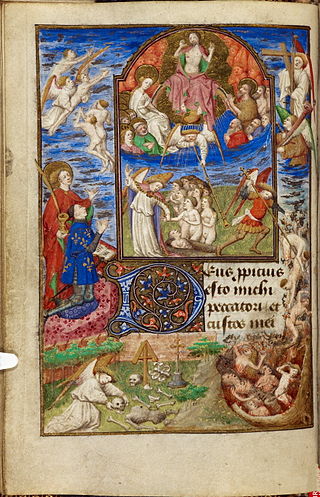
The Dunois Master, also called Chief Associate of the Bedford Master was a French manuscript illuminator believed to have been active between about 1430 and about 1465. His name comes from a book of hours made for Jean de Dunois now in the British Library. He worked in association with the Bedford Master, in whose workshop he seems to have served; scholars consider him to be the most talented of the Bedford Master's assistants. He is usually assumed to have taken over the workshop when the Bedford Master ceased to be active, or to have set up his own with some of the artists. His style is characterized by soft modeling of forms, and a fondness for pale colors and shell gold.

The Petites Heures of Jean de France, Duc de Berry is an illuminated book of hours commissioned by John, Duke of Berry between 1375 and 1385–90. It is known for its ornate miniature leaves and border decorations.
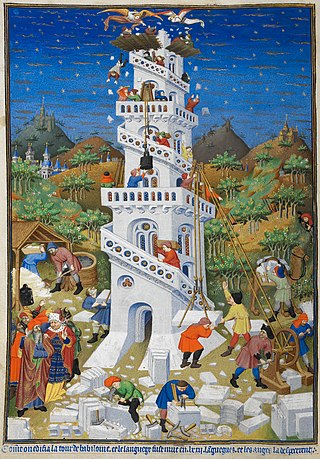
The Bedford Hours is a French late medieval book of hours. It dates to the early fifteenth century (c. 1410–30); some of its miniatures, including the portraits of the Duke and Duchess of Bedford, have been attributed to the Bedford Master and his workshop in Paris. The Duke and Duchess of Bedford gave the book to their nephew Henry VI in 1430. It is in the British Library, catalogued as Add MS 18850.

The Pseudo-Jacquemart was an anonymous master illuminator active in Paris and Bourges between 1380 and 1415. He owed his name to his close collaboration with painter Jacquemart de Hesdin.

The Ravenelle Hours, or the Book of Hours of Johannete Ravenelle, is a 15th-century book of hours made in Paris, France and kept in Uppsala University Library, Sweden. It belonged to Johannete Ravenelle, probably a middle-class woman, and was made by the so-called Ravenelle Painter. It has been dated to 1400–1405. Both stylistically and in subject matter it is a typical representative of books of hours made in Paris at this time. Its decoration includes 14 miniatures as well as other decorative elements. It is not known how the book came to Sweden; it was bought by Uppsala University Library from a private collector in 1953. It is bound in a binding from the turn of the twentieth century.

The Master of Jouvenel was an anonymous master illuminator active between 1447 and 1460. The painter, to whom many manuscripts are attributed, was undoubtedly at the head of a workshop, also called Groupe Jouvenel from which the Master of Boccace of Geneva came from, or the Master of Boethius. The painter owes his name to a manuscript in the Mare Historium commissioned by Guillaume Jouvenel des Ursins, for which his workshop produced 730 miniatures.

The Master of the Jardin de vertueuse consolation is the Notname of an illuminator active in Bruges in the years 1450 to 1475. He owes his name to a work by Pierre d'Ailly of which the decoration has been attributed to him, Le Jardin de vertueuse consolation, executed for Louis de Gruuthuse and today preserved in the Bibliothèque nationale de France as ms. fr. 1026.
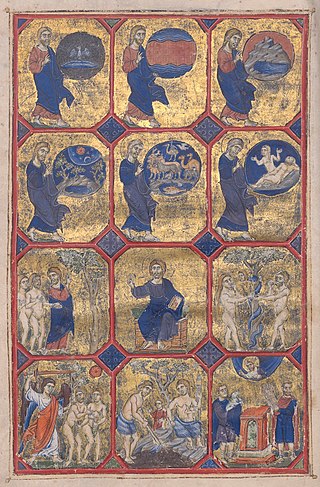
The Acre Bible is a partial Old French version of the Old Testament, containing both new and revised translations of 15 canonical and 4 deuterocanonical books, plus a prologue and glosses. The books are Genesis, Exodus, Leviticus, Numbers, Deuteronomy, Joshua, Judges, 1 and 2 Samuel, 1 and 2 Kings, Judith, Esther, Job, Tobit, Proverbs, 1 and 2 Maccabees and Ruth. It is an early and somewhat rough vernacular translation. Its version of Job is the earliest vernacular translation in Western Europe.

The Master of the Burgundian Prelates was an anonymous master illuminator active in Burgundy between 1470 and 1490. He owes his name to several works commissioned from him by Burgundian bishops and abbots.



















